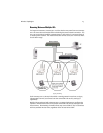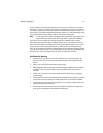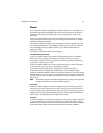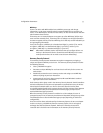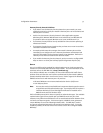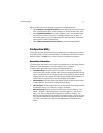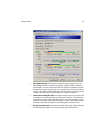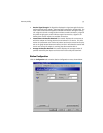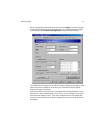Configuration Parameters 33
WEP Keys
An 802.11a device with WEP enabled uses a WEP Key to encrypt and decrypt
information. A user must manually enter the network’s WEP Keys on each 802.11a
device. If the WEP Keys do not match on two radios, no data communication will take
place between these devices.
A Harmony 802.11a network adapter can support up to four WEP Keys (all four Keys
must have the same Key Size). A Harmony 802.11a adapter can decrypt information
that was encrypted with any of its four WEP Keys, but it will only use the Default Key to
encrypt outgoing information.
For 64-bit encryption, a WEP Key is 10 hexadecimal digits (0-9 and A-F); for 128-bit
encryption, a WEP Key is 26 hexadecimal digits (0-9 and A-F); and for 152-bit
encryption, a WEP Key is 32 hexadecimal digits (0-9 and A-F).
Note: When WEP is enabled, Proxim recommends that you configure all 802.11a
devices in the Extended Service Set with the same WEP Keys in the same
order (but the devices do not need to use the same default Key).
Harmony Security Protocol
The Harmony Security Protocol automates encryption management, assigning a
unique and dynamic WEP Key to each user. The Harmony Security Protocol includes
the following features:
• Uses 152-Bit WEP Encryption
• Generates a unique WEP Key for each user that is valid only for the current net-
work session
• Periodically renews the user’s Harmony session and assigns a new WEP Key
without requiring any end user interaction
• Incorporates the end user’s logon prompt into Microsoft Windows’ standard
logon procedure on the client device
Each Harmony device plays a role in the Harmony Security Protocol: the AP Controllers
maintain a database of user name and passwords to authenticate users; the Access
Points block all network traffic to or from a client until after the user has been
successfully authenticated by the Harmony System; and the Harmony client adapters
include a software utility that incorporates the Harmony logon prompt into the
standard Windows logon procedure.
When the Harmony Security Protocol is enabled on a client adapter, the user is
prompted to enter his or her Harmony User Name and Password during boot up, either
immediately before or after the Windows logon prompt (depending on the device
configuration).
Once the user has been authenticated by the Harmony System, the 802.11a adapter
receives a unique 152-bit WEP Key from the Harmony System, and it can begin to
exchange data with the Ethernet network. Refer to the
Harmony Access Point
Controller User’s Guide
for more information on the Harmony Security Protocol.



